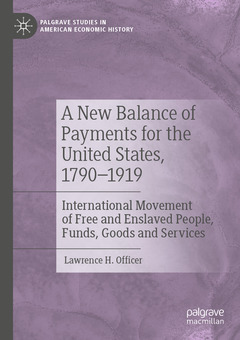A New Balance of Payments for the United States, 1790–1919, 1st ed. 2021 International Movement of Free and Enslaved People, Funds, Goods and Services Palgrave Studies in American Economic History Series
Auteur : Officer Lawrence H.

This book develops new balance of payments statistics for the United States from 1790 to 1919, before official statistics were kept. Part I of this book justifies construction of a new balance of payments table, and Chapter 1 surveys existing tables from that standpoint. Chapter 2 shows how this book overcomes the limitations of Office of Business Economics and its North-Simon-Goldsmith foundation. Specific features are highlighted, including measurement decisions, improvement of OBE series, development of new series, and derived implications for the structure of the US economy and for the importance of individual sectors that loom large at various times: slave trade, shipping, manufacturing, and travel. The book then generates new time series of the movement of people, the movement of goods, the movement of funds, and the provision of services. Part VI puts the new balance of payments table to use in several ways: aggregates and balances within the table, structure of the US economy, and specific sectors of the economy (slave trade, shipping, manufacturing, travel). Finally, Part VII provides concluding comments.
Part I. WHY A NEW BALANCE OF PAYMENTS.- Chapter 1. Existing Historical Balance of Payments: A Survey.- Chapter 2. New Balance of Payments: Features and Implications.- Part II. MOVEMENT OF PEOPLE.- Chapter 3. Free People: Oceanic and Overland.- Chapter 4. Slaves: Oceanic.- Chapter 5. Passengers: Domestic.- Part III. MOVEMENT OF GOODS.- Chapter 6. Merchandise Exports.- Chapter 7. Merchandise Imports.- Chapter 8. Gold and Silver.- Chapter 9. Ships and Slaves.- Part IV. MOVEMENT OF FUNDS.- Chapter 10. Unilateral Transfers.- Chapter 11. Capital.- Chapter 12. Income.- Part V. PROVISION OF SERVICES.- Chapter 13. Transportation.- Chapter 14. Travel.- Chapter 15. Fares.- Chapter 16. Financial.- Chapter 17. Military and Slaves.- Part VI. IMPLICATIONS.- Chapter 18. Aggregates and Balances.- Chapter 19. Structure.- Chapter 20. Sectors.- Part VII. CONCLUSIONS.- Chapter 21. Concluding Comments.
Lawrence H. Officer is Professor of Economics at the University of Illinois at Chicago, USA.
Date de parution : 03-2022
Ouvrage de 415 p.
14.8x21 cm
Date de parution : 03-2021
Ouvrage de 415 p.
14.8x21 cm



